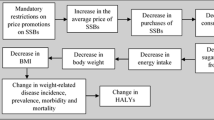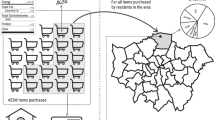Abstract
Objectives
The objective of the present study was to investigate the relationship between price and sales volume of non-alcoholic sugar-sweetened beverages (SSBs), diet drinks, sweets and chocolates, including own and cross price elasticity to further quantify the potential impact of price.
Methods
The study was based on retail scanner data for grocery sales from retail outlet chains in Denmark during the year 2008–2015. A fixed-effects model was used to estimate the association between price and sales volume, using own price and cross price elasticity.
Results
Sales volume of all sugary products except for chocolates were significantly negatively associated with price. Own price elasticity varied from −0.3 to −0.4 for drinks and sweets indicating that a 10% increase in price would cause a reduction in sales by 3 or 4%. A 10% increase in price of carbonated SSBs would increase sales of diet drinks by 7%. Cross price elasticities for other products were not significant.
Conclusions
The results of the present study demonstrated significant negative associations between changes in price and changes in the sale of SSBs, diet drinks and sweets.
This is a preview of subscription content, access via your institution
Access options
Subscribe to this journal
Receive 12 print issues and online access
$259.00 per year
only $21.58 per issue
Buy this article
- Purchase on Springer Link
- Instant access to full article PDF
Prices may be subject to local taxes which are calculated during checkout

Similar content being viewed by others
References
Swinburn BA, Sacks G, Hall KD, McPherson K, Finegood DT, Moodie ML, et al. The global obesity pandemic: shaped by global drivers and local environments. Lancet. 2011;378:804–14.
Drewnowski A, Darmon N. The economics of obesity: dietary energy density and energy cost. Am J Clin Nutr. 2005;82(1 Suppl):265S–273S.
Cash S, Lacanilao R. Taxing food to improve health. Agric Resour Econ Rev. 2007;36:174–82.
Jones NR, Conklin AI, Suhrcke M, Monsivais P. The growing price gap between more and less healthy foods: analysis of a novel longitudinal UK dataset. PLoS ONE. 2014;9:e109343.
Powell LM, Chriqui JF, Khan T, Wada R, Chaloupka FJ. Assessing the potential effectiveness of food and beverage taxes and subsidies for improving public health: a systematic review of prices, demand and body weight outcomes. Obes Rev. 2013;14:110–28.
Pedersen AN, Christensen T, Matthiessen J, Knudsen VK, Rosenlund-Sørensen M, Biltoft-Jensen A, et al. Danskernes kostvaner 2011–2013. Hovedresultater. DTU Fødevareinstituttet: Søborg; 2015.
Matthiessen J, Fagt S, Biltoft-Jensen A, Beck AM, Ovesen L. Size makes a difference. Public Health Nutr. 2003;6:65–72.
Malik VS, Pan A, Willett WC, Hu FB. Sugar-sweetened beverages and weight gain in children and adults: a systematic review and meta-analysis. Am J Clin Nutr. 2013;98:1084–102.
World Health Organization. Guideline: Sugars intake for adults and children: Geneva, 2015.
Bleich SN, Vercammen KA. The negative impact of sugar-sweetened beverages on children’s health: an update of the literature. BMC Obes. 2018;5:6.
Jha P, Chaloupka FJ. The economics of global tobacco control. BMJ. 2000;321:358–61.
Andreyeva T, Long MW, Brownell KD. The impact of food prices on consumption: a systematic review of research on the price elasticity of demand for food. Am J Public Health. 2010;100:216–22.
Cabrera Escobar MA, Veerman JL, Tollman SM, Bertram MY, Hofman KJ. Evidence that a tax on sugar sweetened beverages reduces the obesity rate: a meta-analysis. BMC Public Health. 2013;13:1072.
Cornelsen L, Green R, Turner R, Dangour AD, Shankar B, Mazzocchi M, et al. What Happens to Patterns of Food Consumption when Food Prices Change? Evidence from A Systematic Review and Meta-Analysis of Food Price Elasticities Globally. Health Econ. 2015;24:1548–59.
World Health Organization. Fiscal Policies for Diet and Prevention of Noncommunicable Diseases: Technical Meeting Report, 5-6 May 2015: Geneva, 2016.
World Cancer Research Fund. Building Momentum: Lessons on implementing a robust sugar sweetened beverage tax: Available at: www.wcrf.org/buildingmomentum, 2018.
Silver LD, Ng SW, Ryan-Ibarra S, Taillie LS, Induni M, Miles DR, et al. Changes in prices, sales, consumer spending, and beverage consumption one year after a tax on sugar-sweetened beverages in Berkeley, California, US: A before-and-after study. PLoS Med. 2017;14:e1002283.
Backholer K, Vandevijvere S, Blake M, Tseng M. Sugar-sweetened beverage taxes in 2018: a year of reflections and consolidation. Public Health Nutr. 2018;21:3291–5.
Smith RD, Cornelsen L, Quirmbach D, Jebb SA, Marteau TM. Are sweet snacks more sensitive to price increases than sugar-sweetened beverages: analysis of British food purchase data. BMJ Open. 2018;8:e019788.
Jensen JD, Smed S. State-of-the-art for food taxes to promote public health. Proc Nutr Soc. 2018;77:100–5.
The Danish Customs and Tax Administration. Afgiftsstigning på usunde fødevarer, vin, øl, chokolade mv. (In English: Tax increase on unhealthy foods, wine, beer, chocolate etc.): The Danish Customs and Tax Administration; 2012 [accessed 2018 November 30th]. Available from: https://skat.dk/skat.aspx?oid=2067450.
Finansdepartementet. Avgiftssatser 2018 (In English: Taxes 2018): Finansdepartementet; 2017 [Accessed 2018 Dec 3rd]. Available from: https://www.regjeringen.no/no/tema/okonomi-og-budsjett/skatter-og-avgifter/avgiftssatser-2018/id2575160/.
Adam AS, Smed S. The effects of different types of taxes on soft-drink consumption. University of Copenhagen, Department of Food and Resource Economics, 2012.
Varian HR. Constant Elasticity Demands. In: Repcheck J (ed) Intermediate Microeconomics. A Modern Approach, 8 edn. W.W. Norton and Company: New York, London, 2010, pp 270–292.
Huang J, Tauras J, Chaloupka FJ. The impact of price and tobacco control policies on the demand for electronic nicotine delivery systems. Tob Control. 2014;23(Suppl 3):iii41–47.
Stoklosa M, Drope J, Chaloupka FJ. Prices and E-Cigarette Demand: evidence From the European Union. Nicotine Tob Res. 2016;18:1973–80.
Zellner A. An efficient method of estimating seemingly unrelated regressions and tests for aggregation bias. J Am Stat Assoc. 1962;57:348–68.
Nakhimovsky SS, Feigl AB, Avila C, O’Sullivan G, Macgregor-Skinner E, Spranca M. Taxes on sugar-sweetened beverages to reduce overweight and obesity in middle-income countries: a systematic review. PLoS ONE. 2016;11:e0163358.
Backholer K, Sarink D, Beauchamp A, Keating C, Loh V, Ball K, et al. The impact of a tax on sugar-sweetened beverages according to socio-economic position: a systematic review of the evidence. Public Health Nutr. 2016;19:3070–84.
Nakamura R, Mirelman AJ, Cuadrado C, Silva-Illanes N, Dunstan J, Suhrcke M. Evaluating the 2014 sugar-sweetened beverage tax in Chile: An observational study in urban areas. PLoS Med. 2018;15:e1002596.
Caro JC, Corvalan C, Reyes M, Silva A, Popkin B, Taillie LS. Chile’s 2014 sugar-sweetened beverage tax and changes in prices and purchases of sugar-sweetened beverages: An observational study in an urban environment. PLoS Med. 2018;15:e1002597.
Le Bodo Y, Pacquette M-C, De Wals P. Taxing soda for public health. A Canadian perspective., Springer, 2016.
Ortun V, Lopez-Valcarcel B G, Pinilla J. Tax on sugar sweetened beverages in Spain. Rev Esp Salud Publica. 2016;90:e1–e13.
World Health Organization. Incentives and disincentives for reducing sugar in manufactured foods. An exploratory supply chain analysis: Copenhagen, 2017.
Brownell KD, Farley T, Willett WC, Popkin BM, Chaloupka FJ, Thompson JW, et al. The public health and economic benefits of taxing sugar-sweetened beverages. N Engl J Med. 2009;361:1599–605.
Wright A, Smith KE, Hellowell M. Policy lessons from health taxes: a systematic review of empirical studies. BMC Public Health. 2017;17:583.
Giesbrecht N, Wettlaufer A, Thomas G, Stockwell T, Thompson K, April N, et al. Pricing of alcohol in Canada: A comparison of provincial policies and harm-reduction opportunities. Drug Alcohol Rev. 2016;35:289–97.
The Danish Customs and Tax Administration. E.A Punktafgifter (In English: Exise taxes). Version 1.9: The Danish Customs and Tax Administration; 2013 [Accessed 2019 June 28th]. Available from: https://www.skat.dk/skat.aspx?oid=1921338&chk=206519.
Acknowledgements
This work was supported by Helsefonden.
Author information
Authors and Affiliations
Contributions
TB-A contributed to the conceptualization and design of the study, statistical analyses, interpretation of results, drafting and revision of the manuscript. AHA contributed to the design of the study, statistical analyses, interpretation of results and revision of the manuscript. TJ contributed to the conceptualization and design of the study, interpretation of results and revision of the manuscript. LHE contributed to the design of the study, interpretation of results and revision of the manuscript. UT contributed to the conceptualization and design of the study, interpretation of results and revision of the manuscript. All authors approved the final version of the manuscript.
Corresponding author
Ethics declarations
Conflict of interest
The authors declare that they have no conflict of interest.
Additional information
Publisher’s note: Springer Nature remains neutral with regard to jurisdictional claims in published maps and institutional affiliations.
Supplementary information
41430_2019_470_MOESM1_ESM.docx
Supplementary Table 1. Own price elasticities of sugary products calculated by the two statistical models; general linear model (GLM) and seemingly unrelated regression (SUR)
Rights and permissions
About this article
Cite this article
Buch-Andersen, T., Helms Andreasen, A., Jørgensen, T. et al. Price and sales volume of sugar-sweetened beverages, diet drinks, sweets and chocolates: analysis of Danish retail scanner data. Eur J Clin Nutr 74, 581–587 (2020). https://doi.org/10.1038/s41430-019-0470-5
Received:
Revised:
Accepted:
Published:
Issue Date:
DOI: https://doi.org/10.1038/s41430-019-0470-5



